The Story of geosynclines
Steven Dutch, Professor Emeritus, Natural and Applied Sciences, University of Wisconsin - Green Bay
Structure of a Typical Mountain Range
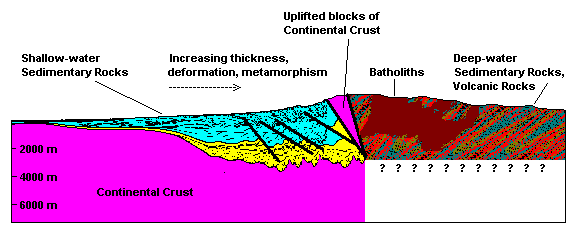
A cross-section through a typical mountain range looks something like this. As we proceed from the stable interior of the continent into the mountain range, we encounter a belt of shallow-water marine sedimentary rocks. These rocks become thicker and more intensely deformed the farther we go into the mountain range. There are frequently uplifted blocks of deep continental crust, then a belt of quite different rocks. In the most intensely-deformed and metamorphosed part of the mountain range, the rocks consist of thick, deep-water marine sedimentary rocks with abundant volcanic rocks. These rocks are often intruded by batholiths.
The Concept of geosynclines
In the late 19th century, geologists interpreted the structure of mountain ranges as shown below. They reasoned that the sedimentary rocks had to accumulate in basins, and since the two belts of rock were so different, there was likely a barrier between them. The uplifted deep crustal rocks found in the cores of many mountain ranges seemed to support the idea of a ridge. The two belts of sedimentary rock were envisioned as accumulating in great troughs, formed by folding of the entire crust. These crustal warps were called geosynclines. The intervening ridge was termed a geanticline. The deep-water, volcanic belt, with its great accumulations of rocks, was called the eugeosyncline (eu = Greek "real"), i.e. the "real" geosyncline, and the shallow-water belt was called the miogeosyncline (mio = Greek "somewhat"), i.e. the "sort of" geosyncline.
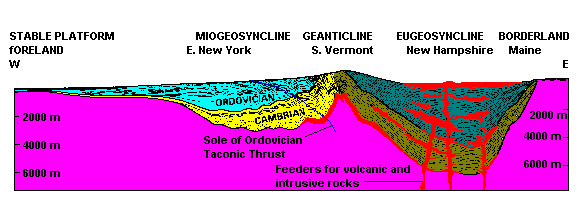
The diagram above is adapted from a classic 1948 book by Marshall Kay called North American geosynclines. It shows an imagined cross-section across the northern Appalachians prior to the Appalachian Orogeny.
I was privileged to know Marshall Kay in graduate school. Kay's book even today contains a wealth of data on the geology of North American orogenic belts. It is no discredit to Kay that he drew the diagram above before plate tectonics was widely accepted. When plate tectonics came along, Kay worked very hard at reinterpreting his ideas in plate tectonic terms, and was actively theorizing and doing field work right up to his death in 1974.
Robert Dietz' Reinterpretation
One bothersome feature of geosynclines was that no contemporary examples seemed to exist. When plate tectonics appeared, the problem became even more acute. It seemed difficult to construct a plate-tectonic cross-section that looked very much like a classic geosyncline.
Around 1970, Robert Dietz took a fresh look at the problem. His approach was to ask, in effect, exactly how much of the classic geosyncline model do we actually see in the field? We understand the shallow-water portion of the sedimentary pile pretty well, we see uplifted basement rocks, and a tremendous pile of deep-water sediments and volcanic rocks, but we really don't see what these rocks are resting on. The diagram below shows what we actually observe.
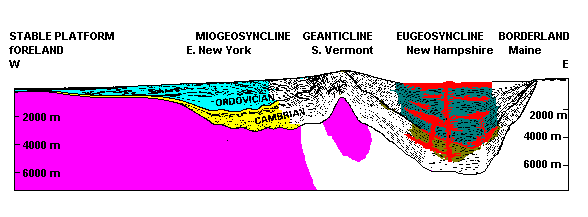
Dietz then asked, if we don't see anything that looks like a classical geosyncline, is there something we do see that looks like what we actually observe in mountain belts? The assemblage of sedimentary rocks looks much like an ordinary continental shelf and slope like we see off the east coast of the United States, as shown below. Dietz realized that geosynclines really aren't synclines, and dropped the "syn" part to coin the term geocline.
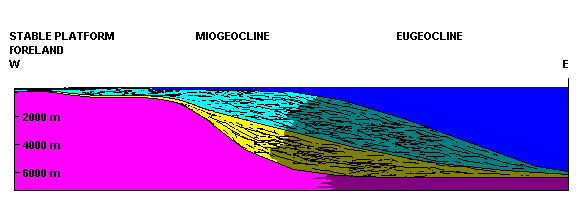
If subduction begins off such a continental margin, volcanic rocks, mixed with sediment eroded from the volcanic arc, will be added to the eugeosynclinal part of the embryonic mountain chain.

Terrane Accretion
In the 1970's geologists began to realize there was another way to make a geosyncline; form the two parts separately and join them later by plate collisions. Much of the Appalachian mio-eugeosyncline pair actually formed this way.
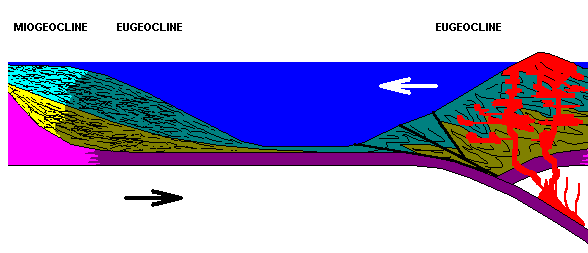
The story of geosynclines is a superb illustration of how scientists can be hampered by conceptual models, and how returning to the actual data and reinterpreting it can solve a problem. The term "geosyncline" is still sometimes used simply because it has a widely-understood meaning. Many geologists, recognizing that geosynclines really aren't synclines, prefer to follow Dietz' usage and speak of geoclines instead.
Return to 296-202 Class Notes Index
Access Crustal Movements Notes Index
Return to Professor Dutch's Home Page
Created 6 January 1998, Last Update 11 January 2020